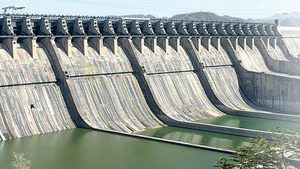Medilytix Bureau : Good rainfall in the catchment area of the Sardar Sarovar dam in Gujarat’s Narmada district has led to the generation of 2,142 million units (MUs) of hydropower so far this year, nearly double as compared to the corresponding period last year.
The month of August has contributed the most to it, the official data has shown.
As per the India Meteorological Department (IMD), both Gujarat and neighbouring Madhya Pradesh have received excess rainfall this monsoon season. Of the Narmada river’s total basin area of 97,410 sq km, a total of 85,858 sq km lies in Madhya Pradesh and 9,894 sq km in Gujarat.
The data shared by the Sardar Sarovar Narmada Nigam Limited (SSNNL) said 2,142 MUs of electricity were produced till September 20 this year as compared to 1,129 MUs till September 30 in 2021, the data shared by the Sardar Sarovar Narmada Nigam Limited (SSNNL) said. RBPH’s installed capacity is 1,200 MW.
Of the 2,142 MUs, a total of 1,849 MUs were generated in the monsoon months of July, August and September. The SSNNL data showed that August was the most productive month for the RBPH this year when it generated 901.298 MUs of power.
“Very good rainfall has led to a significantly higher amount of water released from Madhya Pradesh as compared to last year.” “An increase in the height of the dam since 2017 has also contributed to a rise in power generation,” said K R Parikh, Chief Engineer of SSNNL.
As per the data, during FY 2021-22, the power generated was 923.7 MUs.
In the year 2021, the RBPH generated 1,265.28 MUs of electricity. The RBPH achieved its all-time high power generation of 5,216.80 MUs in FY 2013-14.
As far as power generation crossing the all-time high mark this year is concerned, it all depends on the inflow of water from the catchment area.
We cannot say how long the inflow of water will continue from Madhya Pradesh and how long the overflow will continue. “There is no such forecast, so we cannot say with certainty regarding RBPH power generation breaking the all-time record,” he said.
The Sardar Sarovar Hydroelectric Project (SSHEP) comprises the RBPH and the Canal Head Power House (CHPH), with an installed capacity of 1,200 MW and 250 MW, respectively. The CHPH generated 589.3 MUs of power till September 20 of this year, the data said.
The Narmada, the largest west-flowing river in the Peninsula, rises near the Amarkantak range of mountains in Madhya Pradesh. It traverses through Madhya Pradesh, Maharashtra, and Gujarat.
Madhya Pradesh is the biggest beneficiary of the green electricity generated by the SSHEP complex, which has a total installed capacity of 1,450 MW. Madhya Pradesh draws 57 per cent of the total energy output, followed by Maharashtra at 27 per cent and Gujarat at 16 per cent.
Apart from good rainfall in Madhya Pradesh, an increase in the height of the dam (the top level at which water can be stored) to 138.68 metres with the installation of gates has also helped increase its power generating capacity, official sources said.
This year, the dam reached its full reservoir level (FRL) of 138.68 metres on September 15, for the third time since it was dedicated to the nation on September 17, 2017 after an increase in its height.
The Narmada Control Authority (NCA) had given its final approval to the Gujarat government to raise the height of the dam by about 17 metres, to 138.68 metres, from 121.92 metres in 2014, soon after Narendra Modi became prime minister.
The radial gates on the dam were ready in 2017, and all the gates were opened for the first time in 2019. The dam reached its first FRL on September 15, 2019, then again on September 17, 2020.


